University Nursing Case Study: Professional Practice Analysis - 401021
VerifiedAdded on 2022/09/23
|7
|1741
|41
Case Study
AI Summary
This case study analyzes a clinical incident involving a nurse's professional conduct and its consequences. The case revolves around an 81-year-old patient, Patient A, who experienced deteriorating health due to a lack of proper care and attention from healthcare professionals. The analysis identifies several professional errors, including unethical behavior, failure to uphold the principles of non-maleficence and beneficence, ineffective communication, and inadequate documentation of patient observations. The study examines the contributory factors leading to the patient's death, emphasizing the importance of timely diagnosis, effective communication, and accurate record-keeping. The implications for future practice are discussed, highlighting the significance of ethical and legal principles, therapeutic relationships, patient-centered care, and active involvement of the family. The case study underscores the need for nurses to be responsible, accountable, and committed to providing quality care to ensure better patient outcomes, with a focus on applying nursing working and ethical principles.
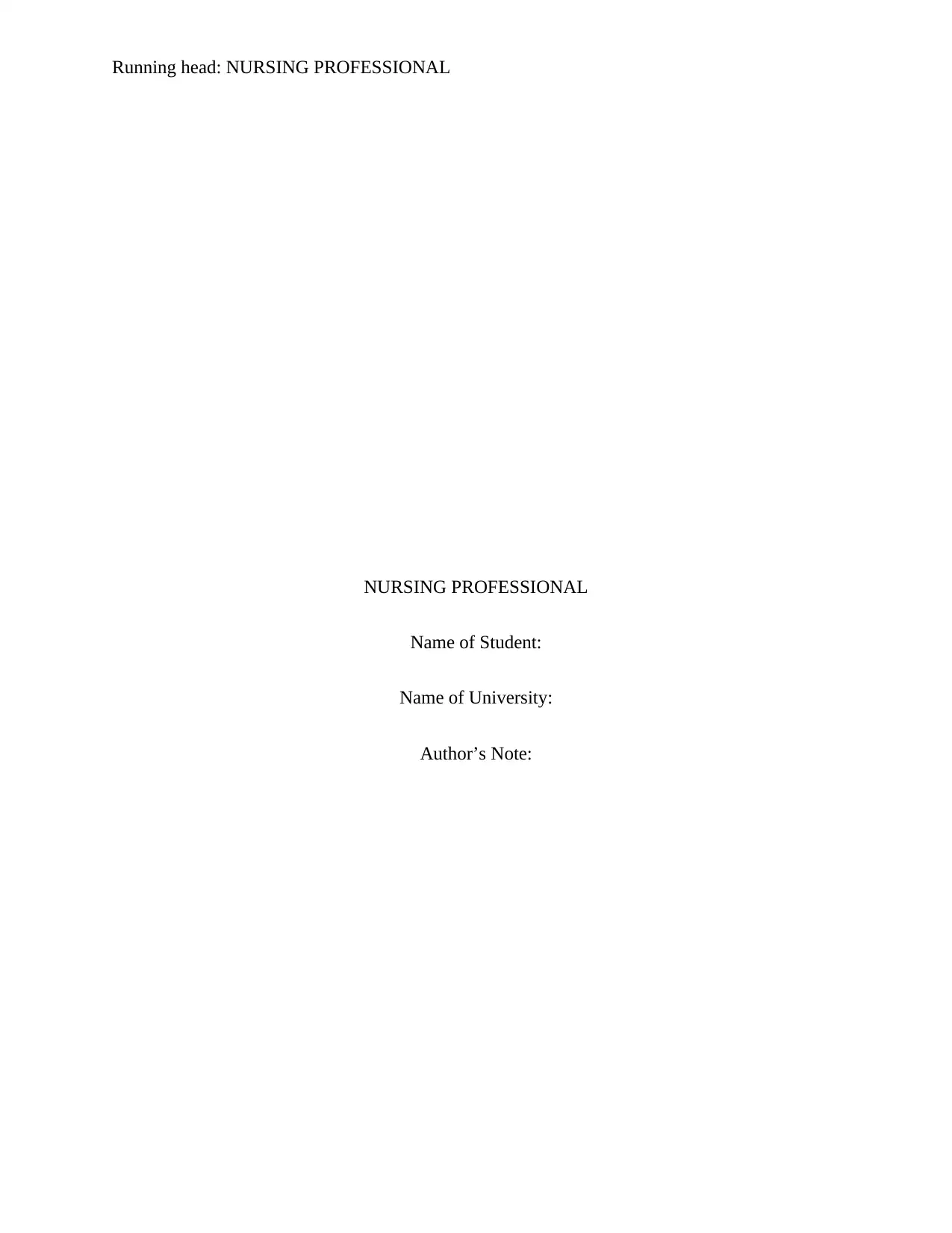
Running head: NURSING PROFESSIONAL
NURSING PROFESSIONAL
Name of Student:
Name of University:
Author’s Note:
NURSING PROFESSIONAL
Name of Student:
Name of University:
Author’s Note:
Paraphrase This Document
Need a fresh take? Get an instant paraphrase of this document with our AI Paraphraser
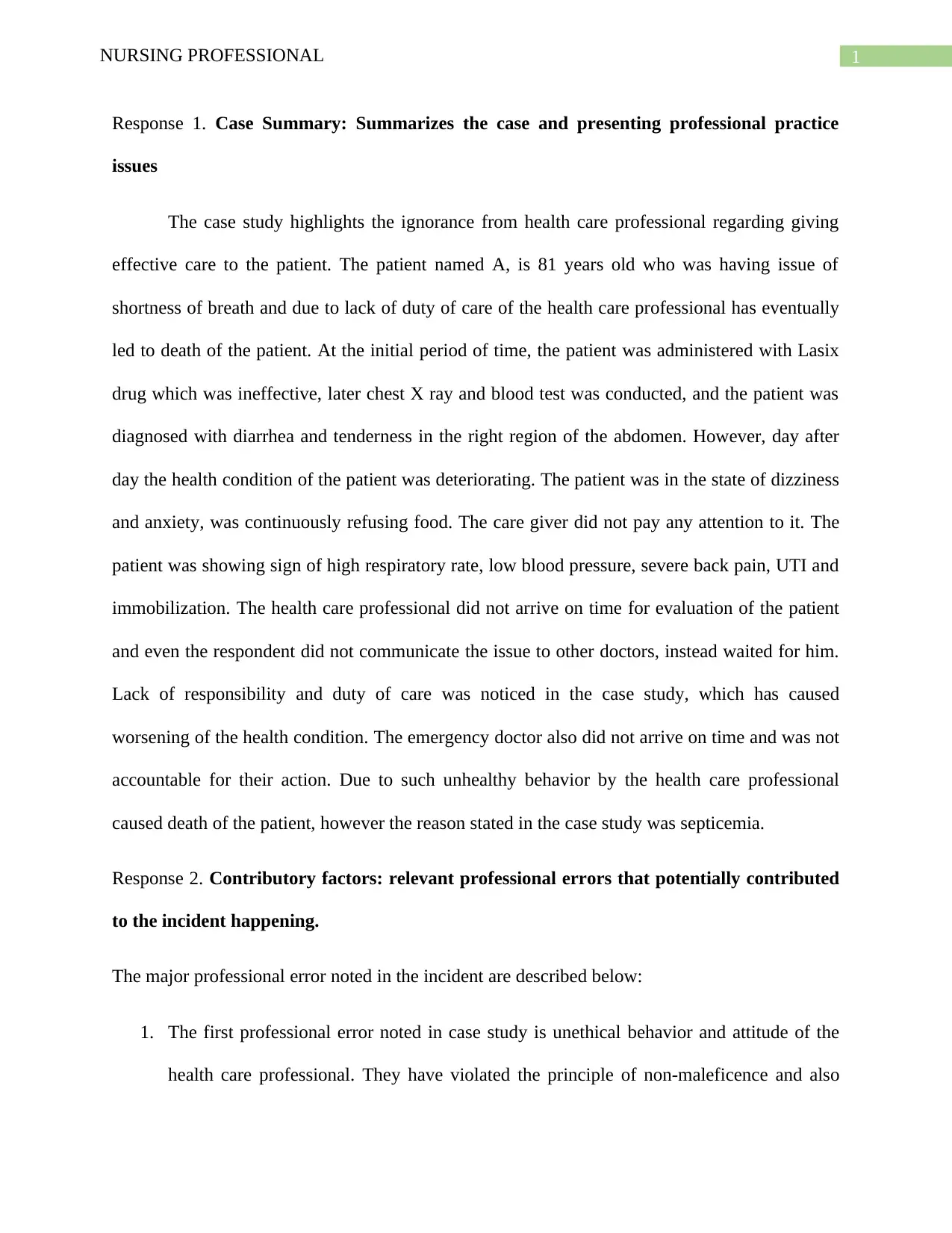
1NURSING PROFESSIONAL
Response 1. Case Summary: Summarizes the case and presenting professional practice
issues
The case study highlights the ignorance from health care professional regarding giving
effective care to the patient. The patient named A, is 81 years old who was having issue of
shortness of breath and due to lack of duty of care of the health care professional has eventually
led to death of the patient. At the initial period of time, the patient was administered with Lasix
drug which was ineffective, later chest X ray and blood test was conducted, and the patient was
diagnosed with diarrhea and tenderness in the right region of the abdomen. However, day after
day the health condition of the patient was deteriorating. The patient was in the state of dizziness
and anxiety, was continuously refusing food. The care giver did not pay any attention to it. The
patient was showing sign of high respiratory rate, low blood pressure, severe back pain, UTI and
immobilization. The health care professional did not arrive on time for evaluation of the patient
and even the respondent did not communicate the issue to other doctors, instead waited for him.
Lack of responsibility and duty of care was noticed in the case study, which has caused
worsening of the health condition. The emergency doctor also did not arrive on time and was not
accountable for their action. Due to such unhealthy behavior by the health care professional
caused death of the patient, however the reason stated in the case study was septicemia.
Response 2. Contributory factors: relevant professional errors that potentially contributed
to the incident happening.
The major professional error noted in the incident are described below:
1. The first professional error noted in case study is unethical behavior and attitude of the
health care professional. They have violated the principle of non-maleficence and also
Response 1. Case Summary: Summarizes the case and presenting professional practice
issues
The case study highlights the ignorance from health care professional regarding giving
effective care to the patient. The patient named A, is 81 years old who was having issue of
shortness of breath and due to lack of duty of care of the health care professional has eventually
led to death of the patient. At the initial period of time, the patient was administered with Lasix
drug which was ineffective, later chest X ray and blood test was conducted, and the patient was
diagnosed with diarrhea and tenderness in the right region of the abdomen. However, day after
day the health condition of the patient was deteriorating. The patient was in the state of dizziness
and anxiety, was continuously refusing food. The care giver did not pay any attention to it. The
patient was showing sign of high respiratory rate, low blood pressure, severe back pain, UTI and
immobilization. The health care professional did not arrive on time for evaluation of the patient
and even the respondent did not communicate the issue to other doctors, instead waited for him.
Lack of responsibility and duty of care was noticed in the case study, which has caused
worsening of the health condition. The emergency doctor also did not arrive on time and was not
accountable for their action. Due to such unhealthy behavior by the health care professional
caused death of the patient, however the reason stated in the case study was septicemia.
Response 2. Contributory factors: relevant professional errors that potentially contributed
to the incident happening.
The major professional error noted in the incident are described below:
1. The first professional error noted in case study is unethical behavior and attitude of the
health care professional. They have violated the principle of non-maleficence and also
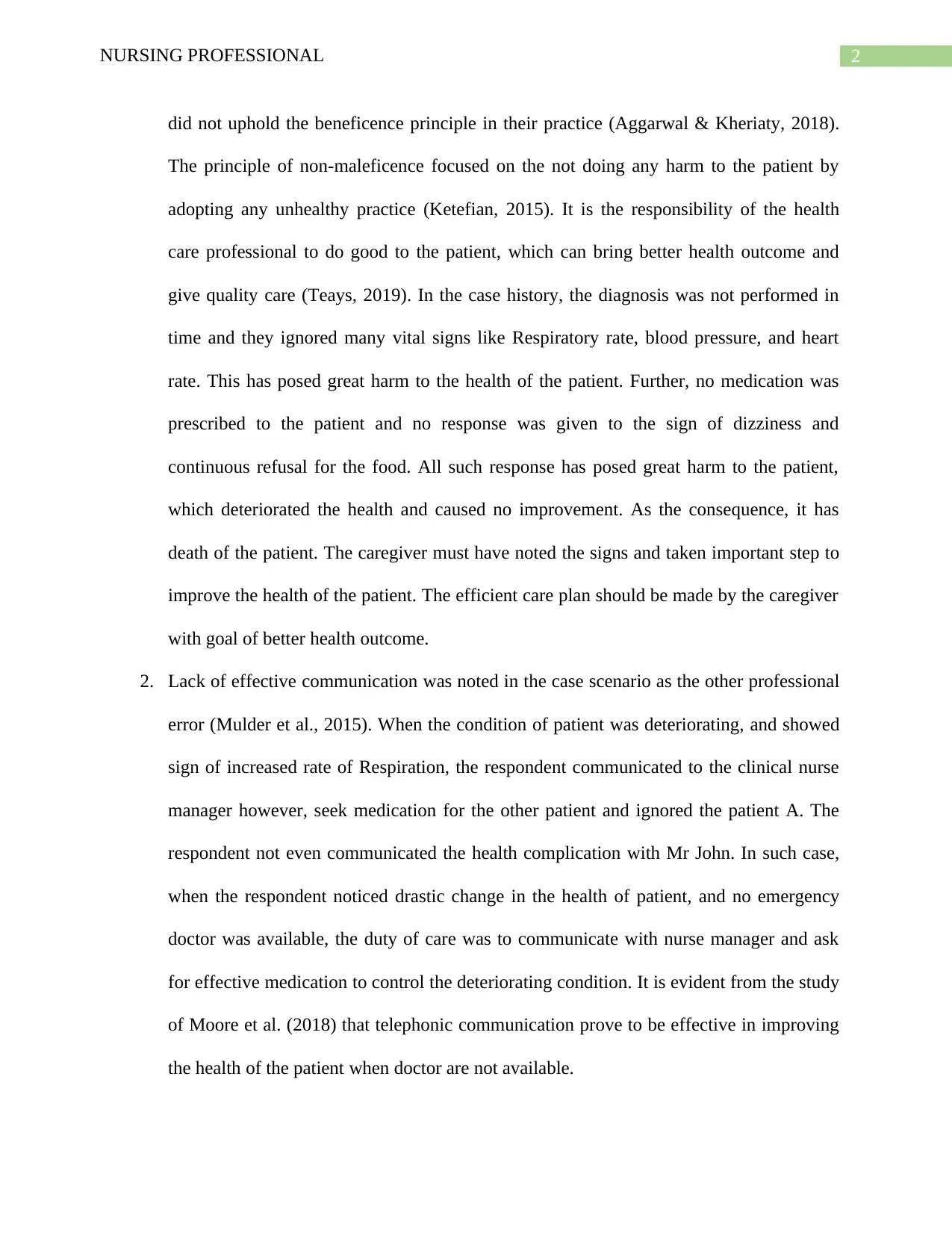
2NURSING PROFESSIONAL
did not uphold the beneficence principle in their practice (Aggarwal & Kheriaty, 2018).
The principle of non-maleficence focused on the not doing any harm to the patient by
adopting any unhealthy practice (Ketefian, 2015). It is the responsibility of the health
care professional to do good to the patient, which can bring better health outcome and
give quality care (Teays, 2019). In the case history, the diagnosis was not performed in
time and they ignored many vital signs like Respiratory rate, blood pressure, and heart
rate. This has posed great harm to the health of the patient. Further, no medication was
prescribed to the patient and no response was given to the sign of dizziness and
continuous refusal for the food. All such response has posed great harm to the patient,
which deteriorated the health and caused no improvement. As the consequence, it has
death of the patient. The caregiver must have noted the signs and taken important step to
improve the health of the patient. The efficient care plan should be made by the caregiver
with goal of better health outcome.
2. Lack of effective communication was noted in the case scenario as the other professional
error (Mulder et al., 2015). When the condition of patient was deteriorating, and showed
sign of increased rate of Respiration, the respondent communicated to the clinical nurse
manager however, seek medication for the other patient and ignored the patient A. The
respondent not even communicated the health complication with Mr John. In such case,
when the respondent noticed drastic change in the health of patient, and no emergency
doctor was available, the duty of care was to communicate with nurse manager and ask
for effective medication to control the deteriorating condition. It is evident from the study
of Moore et al. (2018) that telephonic communication prove to be effective in improving
the health of the patient when doctor are not available.
did not uphold the beneficence principle in their practice (Aggarwal & Kheriaty, 2018).
The principle of non-maleficence focused on the not doing any harm to the patient by
adopting any unhealthy practice (Ketefian, 2015). It is the responsibility of the health
care professional to do good to the patient, which can bring better health outcome and
give quality care (Teays, 2019). In the case history, the diagnosis was not performed in
time and they ignored many vital signs like Respiratory rate, blood pressure, and heart
rate. This has posed great harm to the health of the patient. Further, no medication was
prescribed to the patient and no response was given to the sign of dizziness and
continuous refusal for the food. All such response has posed great harm to the patient,
which deteriorated the health and caused no improvement. As the consequence, it has
death of the patient. The caregiver must have noted the signs and taken important step to
improve the health of the patient. The efficient care plan should be made by the caregiver
with goal of better health outcome.
2. Lack of effective communication was noted in the case scenario as the other professional
error (Mulder et al., 2015). When the condition of patient was deteriorating, and showed
sign of increased rate of Respiration, the respondent communicated to the clinical nurse
manager however, seek medication for the other patient and ignored the patient A. The
respondent not even communicated the health complication with Mr John. In such case,
when the respondent noticed drastic change in the health of patient, and no emergency
doctor was available, the duty of care was to communicate with nurse manager and ask
for effective medication to control the deteriorating condition. It is evident from the study
of Moore et al. (2018) that telephonic communication prove to be effective in improving
the health of the patient when doctor are not available.
⊘ This is a preview!⊘
Do you want full access?
Subscribe today to unlock all pages.

Trusted by 1+ million students worldwide
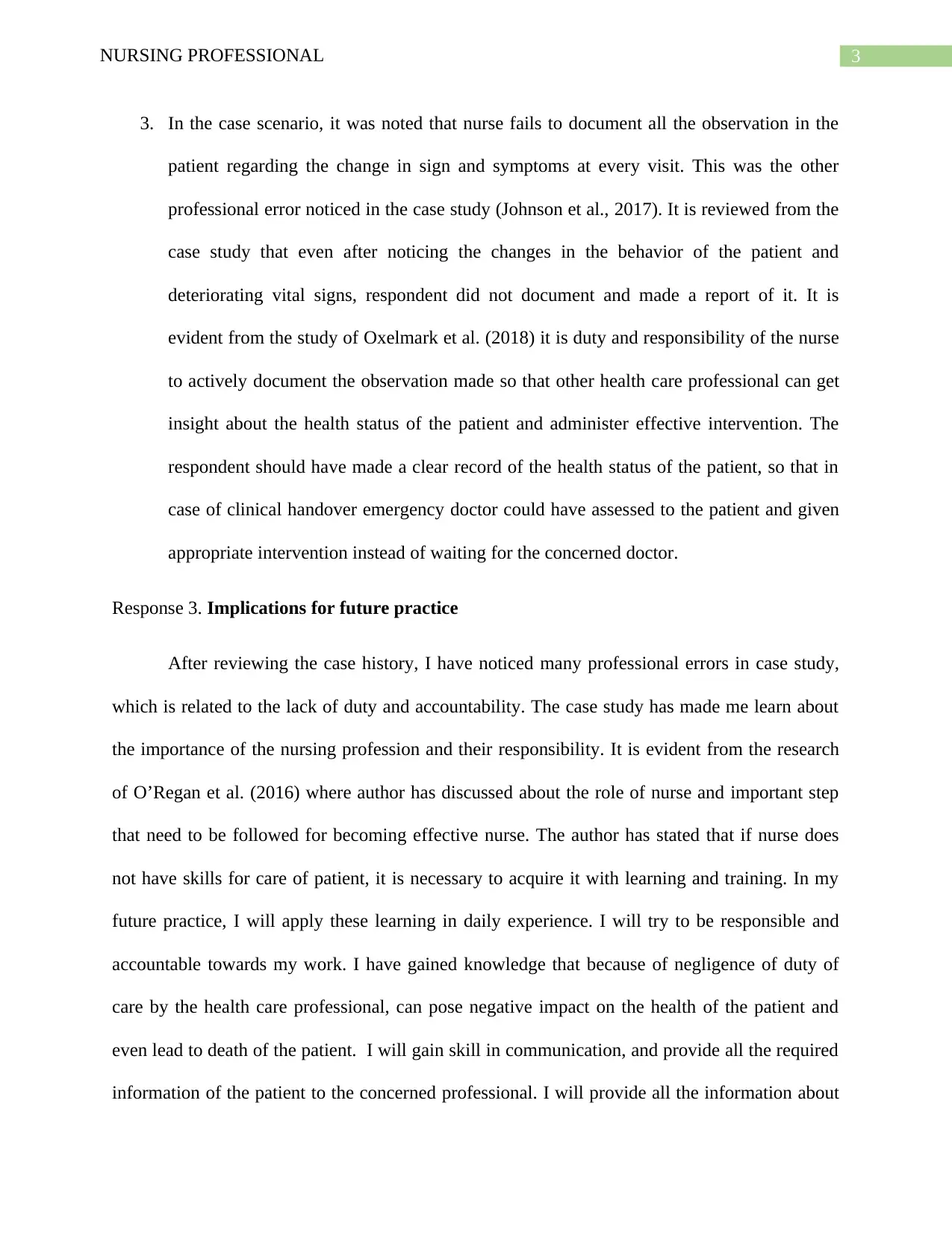
3NURSING PROFESSIONAL
3. In the case scenario, it was noted that nurse fails to document all the observation in the
patient regarding the change in sign and symptoms at every visit. This was the other
professional error noticed in the case study (Johnson et al., 2017). It is reviewed from the
case study that even after noticing the changes in the behavior of the patient and
deteriorating vital signs, respondent did not document and made a report of it. It is
evident from the study of Oxelmark et al. (2018) it is duty and responsibility of the nurse
to actively document the observation made so that other health care professional can get
insight about the health status of the patient and administer effective intervention. The
respondent should have made a clear record of the health status of the patient, so that in
case of clinical handover emergency doctor could have assessed to the patient and given
appropriate intervention instead of waiting for the concerned doctor.
Response 3. Implications for future practice
After reviewing the case history, I have noticed many professional errors in case study,
which is related to the lack of duty and accountability. The case study has made me learn about
the importance of the nursing profession and their responsibility. It is evident from the research
of O’Regan et al. (2016) where author has discussed about the role of nurse and important step
that need to be followed for becoming effective nurse. The author has stated that if nurse does
not have skills for care of patient, it is necessary to acquire it with learning and training. In my
future practice, I will apply these learning in daily experience. I will try to be responsible and
accountable towards my work. I have gained knowledge that because of negligence of duty of
care by the health care professional, can pose negative impact on the health of the patient and
even lead to death of the patient. I will gain skill in communication, and provide all the required
information of the patient to the concerned professional. I will provide all the information about
3. In the case scenario, it was noted that nurse fails to document all the observation in the
patient regarding the change in sign and symptoms at every visit. This was the other
professional error noticed in the case study (Johnson et al., 2017). It is reviewed from the
case study that even after noticing the changes in the behavior of the patient and
deteriorating vital signs, respondent did not document and made a report of it. It is
evident from the study of Oxelmark et al. (2018) it is duty and responsibility of the nurse
to actively document the observation made so that other health care professional can get
insight about the health status of the patient and administer effective intervention. The
respondent should have made a clear record of the health status of the patient, so that in
case of clinical handover emergency doctor could have assessed to the patient and given
appropriate intervention instead of waiting for the concerned doctor.
Response 3. Implications for future practice
After reviewing the case history, I have noticed many professional errors in case study,
which is related to the lack of duty and accountability. The case study has made me learn about
the importance of the nursing profession and their responsibility. It is evident from the research
of O’Regan et al. (2016) where author has discussed about the role of nurse and important step
that need to be followed for becoming effective nurse. The author has stated that if nurse does
not have skills for care of patient, it is necessary to acquire it with learning and training. In my
future practice, I will apply these learning in daily experience. I will try to be responsible and
accountable towards my work. I have gained knowledge that because of negligence of duty of
care by the health care professional, can pose negative impact on the health of the patient and
even lead to death of the patient. I will gain skill in communication, and provide all the required
information of the patient to the concerned professional. I will provide all the information about
Paraphrase This Document
Need a fresh take? Get an instant paraphrase of this document with our AI Paraphraser
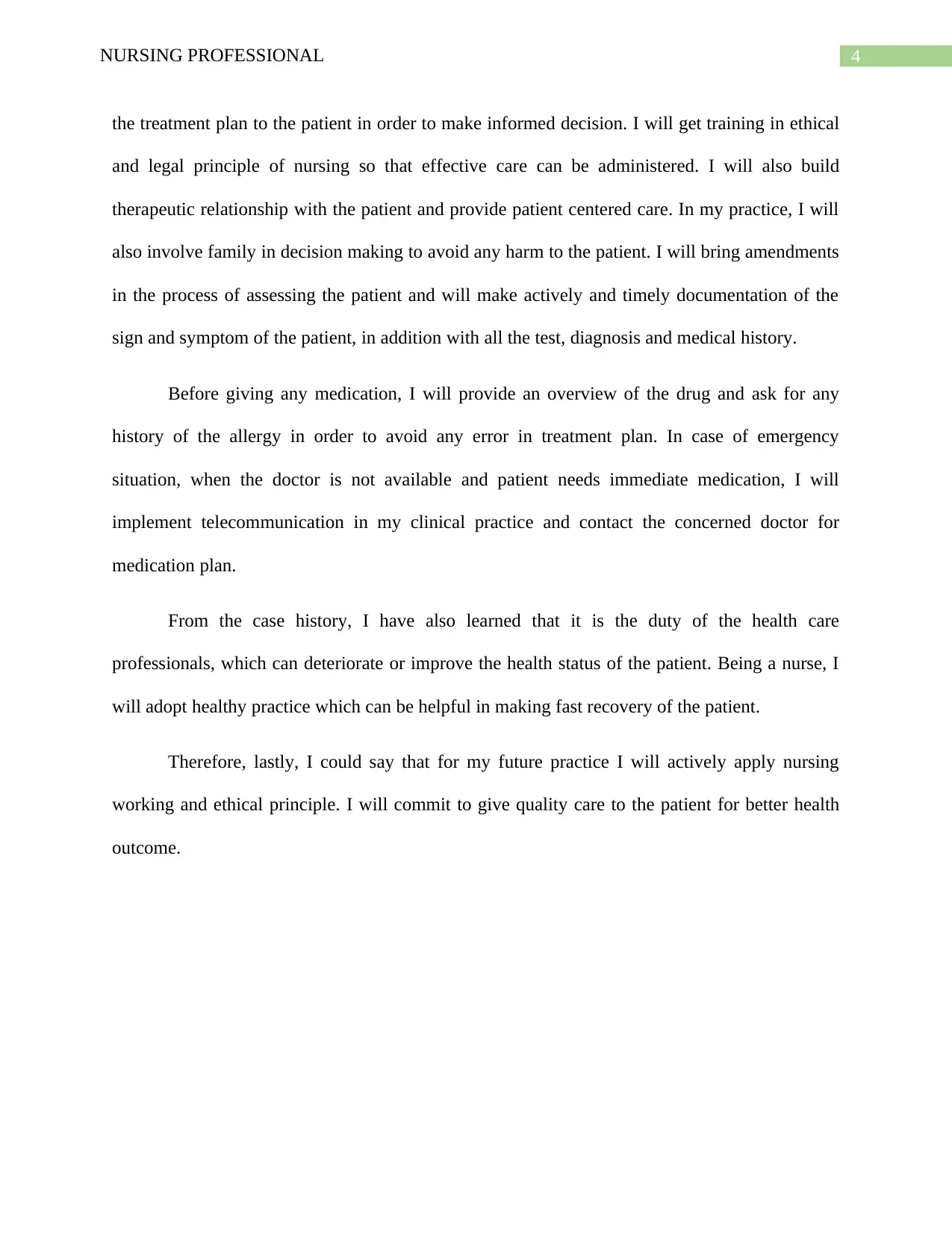
4NURSING PROFESSIONAL
the treatment plan to the patient in order to make informed decision. I will get training in ethical
and legal principle of nursing so that effective care can be administered. I will also build
therapeutic relationship with the patient and provide patient centered care. In my practice, I will
also involve family in decision making to avoid any harm to the patient. I will bring amendments
in the process of assessing the patient and will make actively and timely documentation of the
sign and symptom of the patient, in addition with all the test, diagnosis and medical history.
Before giving any medication, I will provide an overview of the drug and ask for any
history of the allergy in order to avoid any error in treatment plan. In case of emergency
situation, when the doctor is not available and patient needs immediate medication, I will
implement telecommunication in my clinical practice and contact the concerned doctor for
medication plan.
From the case history, I have also learned that it is the duty of the health care
professionals, which can deteriorate or improve the health status of the patient. Being a nurse, I
will adopt healthy practice which can be helpful in making fast recovery of the patient.
Therefore, lastly, I could say that for my future practice I will actively apply nursing
working and ethical principle. I will commit to give quality care to the patient for better health
outcome.
the treatment plan to the patient in order to make informed decision. I will get training in ethical
and legal principle of nursing so that effective care can be administered. I will also build
therapeutic relationship with the patient and provide patient centered care. In my practice, I will
also involve family in decision making to avoid any harm to the patient. I will bring amendments
in the process of assessing the patient and will make actively and timely documentation of the
sign and symptom of the patient, in addition with all the test, diagnosis and medical history.
Before giving any medication, I will provide an overview of the drug and ask for any
history of the allergy in order to avoid any error in treatment plan. In case of emergency
situation, when the doctor is not available and patient needs immediate medication, I will
implement telecommunication in my clinical practice and contact the concerned doctor for
medication plan.
From the case history, I have also learned that it is the duty of the health care
professionals, which can deteriorate or improve the health status of the patient. Being a nurse, I
will adopt healthy practice which can be helpful in making fast recovery of the patient.
Therefore, lastly, I could say that for my future practice I will actively apply nursing
working and ethical principle. I will commit to give quality care to the patient for better health
outcome.
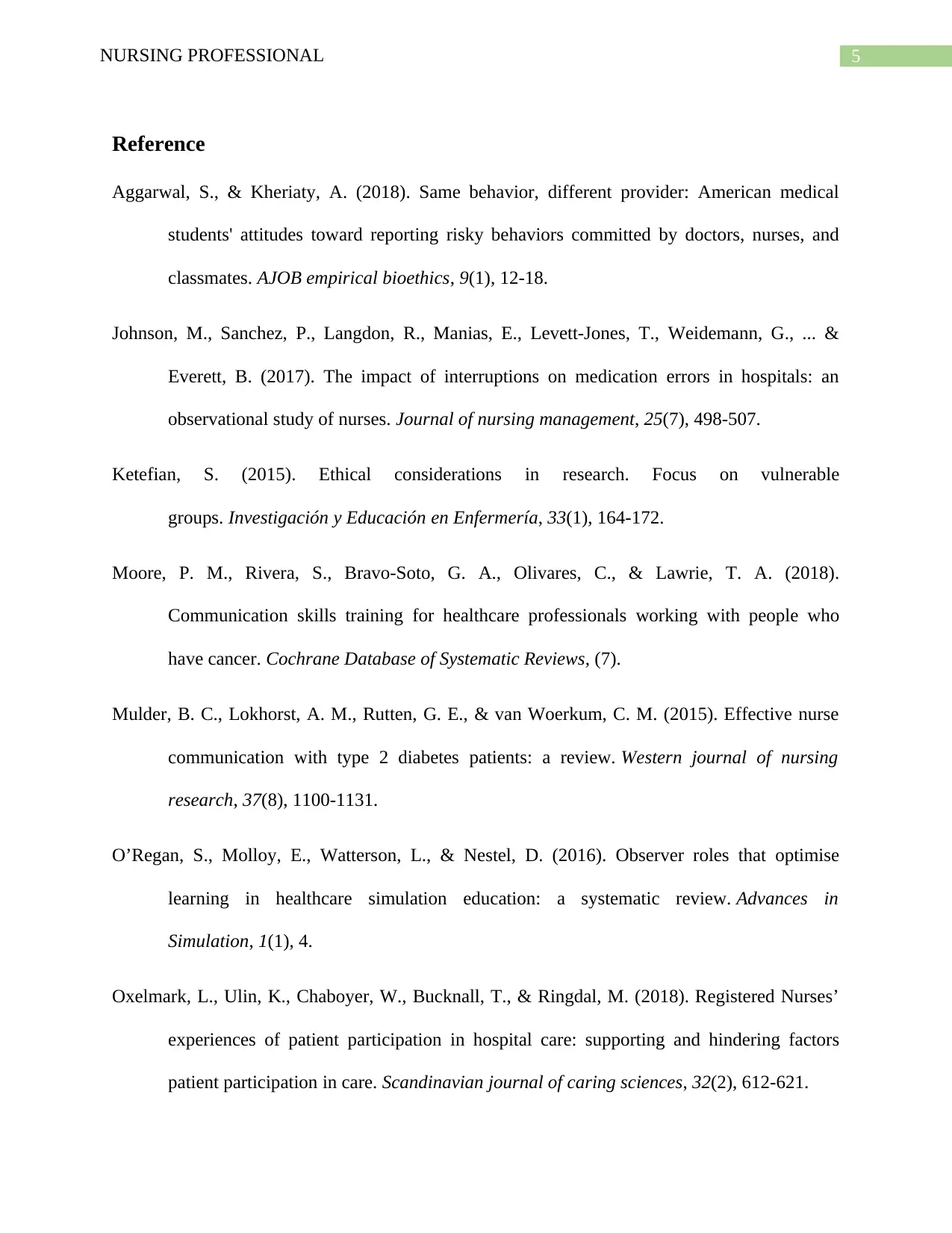
5NURSING PROFESSIONAL
Reference
Aggarwal, S., & Kheriaty, A. (2018). Same behavior, different provider: American medical
students' attitudes toward reporting risky behaviors committed by doctors, nurses, and
classmates. AJOB empirical bioethics, 9(1), 12-18.
Johnson, M., Sanchez, P., Langdon, R., Manias, E., Levett‐Jones, T., Weidemann, G., ... &
Everett, B. (2017). The impact of interruptions on medication errors in hospitals: an
observational study of nurses. Journal of nursing management, 25(7), 498-507.
Ketefian, S. (2015). Ethical considerations in research. Focus on vulnerable
groups. Investigación y Educación en Enfermería, 33(1), 164-172.
Moore, P. M., Rivera, S., Bravo‐Soto, G. A., Olivares, C., & Lawrie, T. A. (2018).
Communication skills training for healthcare professionals working with people who
have cancer. Cochrane Database of Systematic Reviews, (7).
Mulder, B. C., Lokhorst, A. M., Rutten, G. E., & van Woerkum, C. M. (2015). Effective nurse
communication with type 2 diabetes patients: a review. Western journal of nursing
research, 37(8), 1100-1131.
O’Regan, S., Molloy, E., Watterson, L., & Nestel, D. (2016). Observer roles that optimise
learning in healthcare simulation education: a systematic review. Advances in
Simulation, 1(1), 4.
Oxelmark, L., Ulin, K., Chaboyer, W., Bucknall, T., & Ringdal, M. (2018). Registered Nurses’
experiences of patient participation in hospital care: supporting and hindering factors
patient participation in care. Scandinavian journal of caring sciences, 32(2), 612-621.
Reference
Aggarwal, S., & Kheriaty, A. (2018). Same behavior, different provider: American medical
students' attitudes toward reporting risky behaviors committed by doctors, nurses, and
classmates. AJOB empirical bioethics, 9(1), 12-18.
Johnson, M., Sanchez, P., Langdon, R., Manias, E., Levett‐Jones, T., Weidemann, G., ... &
Everett, B. (2017). The impact of interruptions on medication errors in hospitals: an
observational study of nurses. Journal of nursing management, 25(7), 498-507.
Ketefian, S. (2015). Ethical considerations in research. Focus on vulnerable
groups. Investigación y Educación en Enfermería, 33(1), 164-172.
Moore, P. M., Rivera, S., Bravo‐Soto, G. A., Olivares, C., & Lawrie, T. A. (2018).
Communication skills training for healthcare professionals working with people who
have cancer. Cochrane Database of Systematic Reviews, (7).
Mulder, B. C., Lokhorst, A. M., Rutten, G. E., & van Woerkum, C. M. (2015). Effective nurse
communication with type 2 diabetes patients: a review. Western journal of nursing
research, 37(8), 1100-1131.
O’Regan, S., Molloy, E., Watterson, L., & Nestel, D. (2016). Observer roles that optimise
learning in healthcare simulation education: a systematic review. Advances in
Simulation, 1(1), 4.
Oxelmark, L., Ulin, K., Chaboyer, W., Bucknall, T., & Ringdal, M. (2018). Registered Nurses’
experiences of patient participation in hospital care: supporting and hindering factors
patient participation in care. Scandinavian journal of caring sciences, 32(2), 612-621.
⊘ This is a preview!⊘
Do you want full access?
Subscribe today to unlock all pages.

Trusted by 1+ million students worldwide
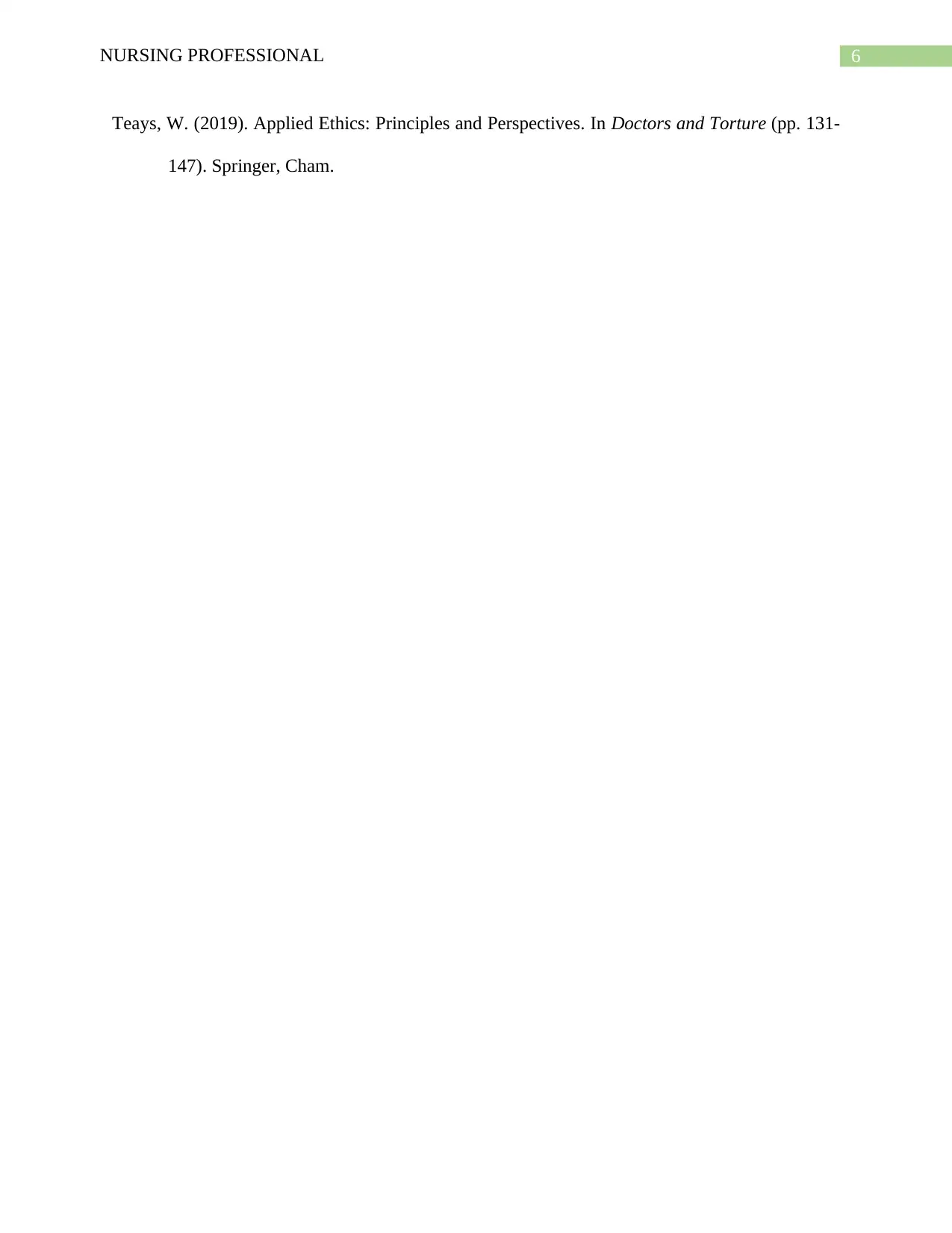
6NURSING PROFESSIONAL
Teays, W. (2019). Applied Ethics: Principles and Perspectives. In Doctors and Torture (pp. 131-
147). Springer, Cham.
Teays, W. (2019). Applied Ethics: Principles and Perspectives. In Doctors and Torture (pp. 131-
147). Springer, Cham.
1 out of 7
Related Documents
Your All-in-One AI-Powered Toolkit for Academic Success.
+13062052269
info@desklib.com
Available 24*7 on WhatsApp / Email
![[object Object]](/_next/static/media/star-bottom.7253800d.svg)
Unlock your academic potential
Copyright © 2020–2025 A2Z Services. All Rights Reserved. Developed and managed by ZUCOL.





